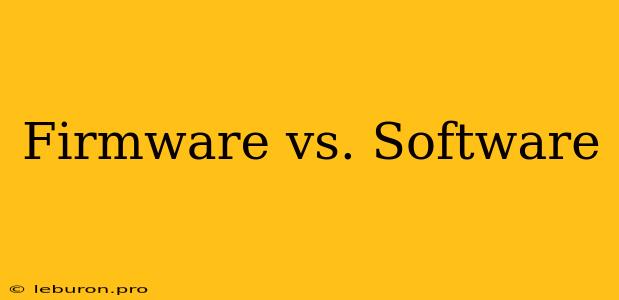The terms "firmware" and "software" are often used interchangeably, but they represent distinct entities in the realm of computer systems. While both are sets of instructions that guide a computer's operation, their roles and functionalities differ significantly. Understanding the differences between firmware and software is crucial for anyone seeking to navigate the intricacies of modern technology. This article will delve into the distinct characteristics, applications, and implications of each, shedding light on their roles in shaping the digital world.
Delving into Firmware: The Embedded Instructions
Firmware is essentially software embedded directly into the hardware of a device. It acts as the foundation upon which other software programs operate, providing the basic instructions required for the device to function. Think of it as the operating system of a specific component within a larger system, enabling that component to communicate with other parts and perform its designated tasks. Firmware is typically stored in non-volatile memory, such as flash memory, ensuring that it persists even when the device is powered off.
Examples of Firmware in Action
To better grasp the concept of firmware, let's consider some real-world examples:
- BIOS (Basic Input/Output System): Found in computers, BIOS acts as the intermediary between the operating system and the hardware. It initializes the system during boot-up, checks the hardware components, and loads the operating system.
- Embedded Systems: From your washing machine to your car, countless devices rely on firmware to control their specific functions. These systems often lack a traditional operating system and rely solely on firmware for their core operations.
- Printers: Printers have firmware embedded within them that manages print jobs, paper handling, and communication with the computer.
Modifying and Updating Firmware
While firmware is typically designed to be immutable, it can sometimes be updated or modified. These updates are often necessary to address security vulnerabilities, improve performance, or add new features. However, firmware updates should only be performed from trusted sources to avoid corrupting the device's functionality.
Software: The Versatile Programs that Run on Your Computer
In contrast to firmware, software is a more encompassing term that refers to programs and data designed to be executed by a computer system. This includes operating systems, applications, and utilities that enhance the user experience. Unlike firmware, software is typically stored on a hard drive or other storage media and can be easily installed, uninstalled, or updated.
Software Categories: A Broad Spectrum of Applications
Software encompasses a wide range of programs, each serving a specific purpose:
- Operating Systems (OS): These provide the foundation upon which all other software runs. Examples include Windows, macOS, Linux, and Android.
- Applications: Designed for specific tasks, applications cater to user needs, ranging from productivity suites like Microsoft Office to entertainment software like video games.
- Utilities: These programs provide essential system functions, such as antivirus protection, disk cleanup tools, and file compression software.
Software's Flexibility and Evolution
Software is highly dynamic and adaptable. It can be readily modified, updated, and customized to meet evolving needs. This flexibility enables continuous innovation and allows developers to address changing user requirements. The rapid advancements in software development have led to the creation of powerful and sophisticated applications, revolutionizing countless industries.
The Interplay of Firmware and Software: A Collaborative Partnership
While seemingly distinct, firmware and software are closely interconnected. They work together to ensure the smooth operation of a device. Firmware provides the essential foundation for software to function, while software leverages the capabilities provided by firmware to deliver its intended functionality.
For instance, the BIOS (firmware) loads the operating system (software), which then allows the user to access and utilize various applications (software). This collaborative relationship enables devices to perform complex tasks and deliver a seamless user experience.
Key Differences between Firmware and Software
To summarize, here are the key distinctions between firmware and software:
| Feature | Firmware | Software |
|---|---|---|
| Location | Embedded in hardware | Stored on storage media |
| Persistence | Non-volatile, persists even when powered off | Volatile, requires power to function |
| Modification | Less frequent, requires specialized tools | Frequent, easily updated and customized |
| Functionality | Basic system control, device communication | User interface, application execution |
| Examples | BIOS, embedded systems, printer controllers | Operating systems, applications, utilities |
Final Thoughts: Understanding the Essence of Firmware and Software
In conclusion, while firmware and software might seem like abstract concepts, they are fundamental to the way we interact with technology. Firmware forms the bedrock of our devices, enabling them to function at a basic level, while software extends their capabilities, providing us with a myriad of tools and experiences. Understanding the differences between these two entities is crucial for anyone seeking to navigate the complexities of the digital world, appreciate the intricacies of technology, and make informed decisions about the software and hardware we use.
